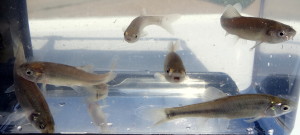Fathead minnow (Pimephales promelas)
Common names: Fathead, black-headed minnow, rosey-red



The fathead minnow is an ideal baitfish species for pond stocking, and due to its many positive attributes is the most recommended baitfish as a purely forage species.
Range: The original range includes much of North America from Quebec to the Northwest Territories, Canada and south to Alabama, Texas and New Mexico, ranging into Mexico. Widely introduced throughout much of the United States and in many other countries including Denmark, Sweden, Finland, Czech Republic, China, Germany, and France.
Description: The fathead minnow has a thick body with a blunt head and small mouth. Fathead minnows are normally dark olive on the upper body, with a lighter silvery shade below, and have a black stripe along the middle of each side. The “rosy red” fathead minnow, developed by Billy Bland Fishery, is orange shading to a lighter silvery orange on the lower body. Male fatheads generally are larger than females; during breeding, normal-colored males develop black heads with several rows of small breeding tubercles (bumps). Females develop an ovipositor, a fleshy protuberance near the vent which is used to help position eggs during spawning.
Biology and Life History: Fatheads usually live only a few years. Fathead minnows are found over much of North America, ranging from Canada to northern Mexico. They are commonly found in slow streams, ponds and lakes, and wetlands. Fathead minnows eat a variety of animals and plants mixed with mud, because they feed on the bottom. Zooplankton is another of their natural foods. Males set up territories under submerged objects and defend these breeding sites from other males. Females are attracted to the males and lay eggs on the undersides of hard surfaces in the water. Spawning substrates provided by farmers include boards, pallets, plastic tarps and irrigation tubing. Once eggs are laid, the male defends the nest until the eggs hatch. Water temperatures higher than 64F trigger spawning. Females spawn at frequent intervals, up to several times a week. Once the water warms to 84F or higher, spawning stops. Fathead minnow eggs are small (1.2 to 1.6 mm).
-SRAC Publication No. 120, Common Farm-Raised Baitfish
Stocking: Fathead minnows are very useful when stocked in catfish only ponds where the catfish are not being fed regularly. They are also ideally stocked into new ponds intended to be stocked with bass and bluegill. In new ponds, fathead minnows should be stocked in the fall at 5-15 pounds per acre with bluegill and redear fingerlings, prior to stocking largemouth bass fingerlings in the spring. In new and established catfish only, hybrid sunfish only, or catfish and hybrid sunfish ponds, fathead minnows should be stocked in the fall at 5-15 pounds per acre and secondary stocking of 5-25 pounds should be made in the spring if the fish are not regularly fed. Fathead minnows are slow swimmers making them vulnerable to predation, which is their intended purpose as baitfish. Pond owners often become concerned that they no longer see fathead minnows within a couple of months of stocking largemouth bass or catfish. This is okay as fathead minnows are stocked to increase first-year growth of bass and bluegill, or supplement the food source for catfish. Once the bluegill population is established, fathead minnows should not need to be restocked into bass-bluegill ponds, but additional stockings to increase the forage base are often made at the pond owners discretion.
